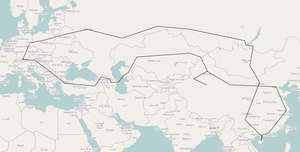Tuesday, May 24. 2011
Listwjanka and Port Baikal
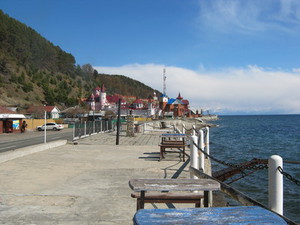 After being in Irkutsk, we headed on to lake Baikal. Although we heared that it's worthwile to visit the nature reserves in the north of the lake, we decided against it, as all options to get there would've involved quite long bus trips.
After being in Irkutsk, we headed on to lake Baikal. Although we heared that it's worthwile to visit the nature reserves in the north of the lake, we decided against it, as all options to get there would've involved quite long bus trips.Listwjanka (Листвянка) is a very tourist oriented village where the Angara River goes into lake Baikal. However, we were there completely out of season. I don't know if there was anyone else in the cheap Hotel we stayed, at least we saw noone else and the older couple running the Hotel seemed to be quite happy with having guests. This was the first time I stayed in a Hotel without any language communication possible.
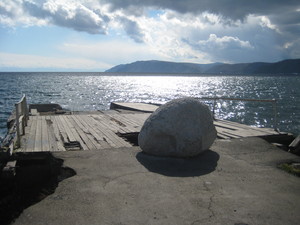 Listwjanka is connected with Port Baikal at the other side of the Angara with a ferry. Listwjanka is not very big, but it's spread several kilometers on the lake's shore. The ferry terminal was somewhat special. I wouldn't have noticed it as being in operation if I hadn't known exactly where it was. There was an old place to board the ferry where already some holes where in the ground and a big rock prevented any cars from getting on it. The ferry just boarded right beside that place. The timetable consisted of a piece of printed paper in plastic.
Listwjanka is connected with Port Baikal at the other side of the Angara with a ferry. Listwjanka is not very big, but it's spread several kilometers on the lake's shore. The ferry terminal was somewhat special. I wouldn't have noticed it as being in operation if I hadn't known exactly where it was. There was an old place to board the ferry where already some holes where in the ground and a big rock prevented any cars from getting on it. The ferry just boarded right beside that place. The timetable consisted of a piece of printed paper in plastic.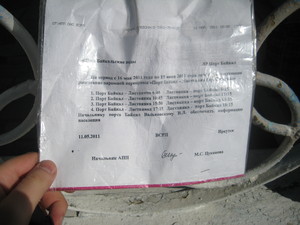 Port Baikal is really small. It wasn't even possible to get a coffee there, it only has some small shops (where we got some very good baked sweets). It is the starting point of the circum baikal railway line. We had to stay several hours, because the ferry only goes a few times a day. Port Baikal gave us a feeling of seeing Russian live in a small village. Some cows were just walking on the "streets" (no paved roads here). I assume Port Baikal has no water supply, as many people were getting water from a pump near the train station.
Port Baikal is really small. It wasn't even possible to get a coffee there, it only has some small shops (where we got some very good baked sweets). It is the starting point of the circum baikal railway line. We had to stay several hours, because the ferry only goes a few times a day. Port Baikal gave us a feeling of seeing Russian live in a small village. Some cows were just walking on the "streets" (no paved roads here). I assume Port Baikal has no water supply, as many people were getting water from a pump near the train station.Pictures from Listwjanka
Pictures from Port Baikal
Irkutsk
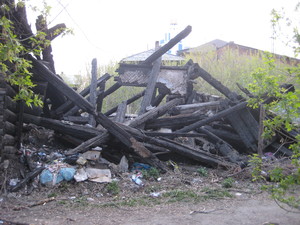 I'm still lagging behind a lot with blogging my trip. So I'll try to keep up a bit.
I'm still lagging behind a lot with blogging my trip. So I'll try to keep up a bit.After Yekaterinburg and a more than two day long train trip, we arrived in Irkutsk (Иркутck) near lake Baikal. Irkutsk is a much more tourist dominated city, which you suddenly notice by the larger number of english speaking people.
What I found noteworthy: At the beginning of our trip, I didn't see much of extreme poverty. This changed in Irkutsk. Large parts of the city are very small houses often in very bad shape. There are very rough breaks - in the same street, you see very modern buildings and a few meters further you see barracks. Also, there were a lot of burned down houses.
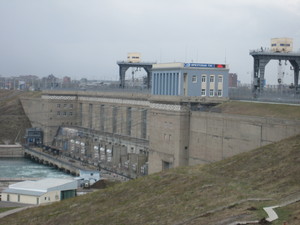 I took the opportunity in Irkutsk to visit the water power plant. It seems not many people consider it an interesting sight, as i was completely alone when I walked on and beside the dam.
I took the opportunity in Irkutsk to visit the water power plant. It seems not many people consider it an interesting sight, as i was completely alone when I walked on and beside the dam.A nice thing to visit was the market in Irkutsk, however, one should be prepared to be spoken to permanently by people trying to sell something to you.
After a short stay in Irkutsk, we went on to lake Baikal and the village Listvijanka (Листвянка).
Pictures from Irkutsk
Pictures from water power plant and dam in Irkutsk
Saturday, May 21. 2011
The Trans-Siberian Railway
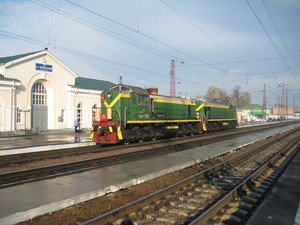 Large parts of our trip to Asia is on the famous Trans-Siberian Railway. It goes from St. Petersburg in the north-west of Russia to Vladivostok in the far south-east and has several sideways like the Trans-Mongolian line and the Trans-Mandshurian line to China. I started my Transsib-trip in Moscow and am currently in Ulan-Ude (Улан-Удэ).
Large parts of our trip to Asia is on the famous Trans-Siberian Railway. It goes from St. Petersburg in the north-west of Russia to Vladivostok in the far south-east and has several sideways like the Trans-Mongolian line and the Trans-Mandshurian line to China. I started my Transsib-trip in Moscow and am currently in Ulan-Ude (Улан-Удэ).Travelling in middle-Europe, one is usually not used to several-day long train tips. On our trip, we used only Platzkart (плацкарт), which is the 3rd and cheapest class which has a bed (on some parts you can get seat only tickets, which are even cheaper, but we always travelled over night, so this was no suitable option). Platzkart means that you're not travelling in small compartments, the whole carriage is one compartment with several beds in it. Although we read in several travelling guides that it's an uncommon option for European travellers, we found it quite satisfying.
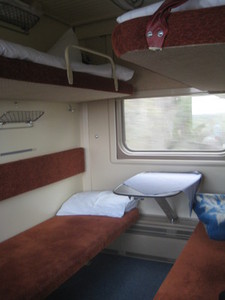 Every carriage has usually two train conductors. Something common on russian trains is that you can always get hot water to make tea or packet soup. I read in advance that there are a lot of food facilities on the stations, but this turned out to be much less of an option than thought. There are usually only small kiosks which all have more or less the same offerings.
Every carriage has usually two train conductors. Something common on russian trains is that you can always get hot water to make tea or packet soup. I read in advance that there are a lot of food facilities on the stations, but this turned out to be much less of an option than thought. There are usually only small kiosks which all have more or less the same offerings.Our longest train-trip was from Yekaterinburg to Irkutsk, which took us more than two days. It was very exhausting and we plan to avoid any more train trips longer than 24 hours for the rest of our journey. We also had some unpleasant experiences with drunken fellow passengers.
Pictures from Train Yekaterinburg - Irkutsk
Update: What I forgot to mention that's very noteworthy: On our trip, the transsiberian train was always very sharp on its schedule, at maximum it was only minutes behind. Very remarkable for several day long train trips.
Monday, May 16. 2011
Yekaterinburg
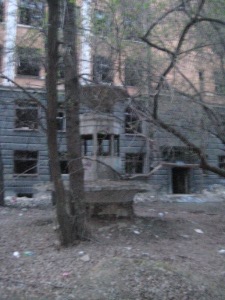 I am a bit behind with blogging my trip - not enough time, and if there's enough time, theres often not enough electricity or internet.
I am a bit behind with blogging my trip - not enough time, and if there's enough time, theres often not enough electricity or internet.We stayed for two days in Yekaterinburg (Екатеринбу́рг), which is the first big asian city if you travel from Europe to Russia. Yekaterinburg is probably a place where international visitors rarely drop by.
We stayed at two couchsurfers who operate a vegetarian shop in an area where vegetarism is barely known at all. So if you are ever in Yekaterinburg and need some tofu or soy milk, be sure to visit their shop.
The most relevant and unpleasant event during our stay was our attempt to get a ticket for our further route. I first thought that this wouldn't be a big issue, as we can order online tickets. But, as I already mentioned before, this is not an option here. For reasons unknown to me, this only works if you board the train at its starting point. So we went to the train station to try to get a ticket. Without much knowledge of Russian language, this was a really tough task and took us several hours. We wrote down the train we wanted to take and some Russian sentences we took from a travel guide. We were sent from one counter to the other, several times the ticket counter closed or made a "15 minute" pause (which in fact were more like 45 minutes) just in front of us. All in all I don't really know when we started this, so I don't know how long it took, but after all, we had the tickets we wanted in our hands - and they were significantly cheaper than any online offer we saw.
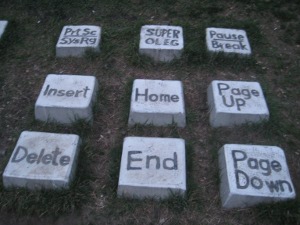 Beside the ticket buying, which took us half a day and limited the time we had to see the city, some interesting places worth mentioning:
Beside the ticket buying, which took us half a day and limited the time we had to see the city, some interesting places worth mentioning:- Yekaterinburg has a very geekish sight: A keyboard monument (some websites like Wikitravel call it the QWERTY monument, but I don't know if that's its official name) - a big keyboard made of stones (map link).
- We were shown an old hospital that was closed about 10 years ago and is now a place where adventurous people do urban exploration and locals tell horror stories about hidden subfloors. Most of the building is in very bad shape and some fountains around it give it a very special atmosphere. A small part of the building however is still operational (I don't know the exact place, but it must be around here).
A common thing to see in Yekaterinburg are trolley busses - busses that uses overhead wires.
What I experienced the first time here was a kind of real-world spam that seems to be common in Russia: In the pedestrian area, many shops used sound systems for advertisement. So you hear a lot of music and loudspeakers telling you the latest cheap offers all the time. Very disturbing.
We've continued our trip to Irkutsk, but I'll write about that later.
Pictures from Yekaterinburg
Wednesday, May 11. 2011
From Moscow to Yekaterinburg
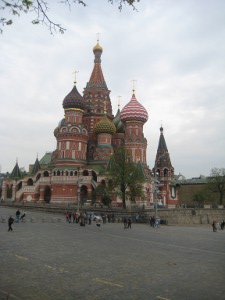 After a 30 hour train trip, we arrived at Moscow Belorussky Terminal (Москва́ Белорусский вокзал). We stayed with some very nice Couchsurfers.
After a 30 hour train trip, we arrived at Moscow Belorussky Terminal (Москва́ Белорусский вокзал). We stayed with some very nice Couchsurfers.We stayed in Moscow for about two days. It'll mainly leave me with two impressions. First, Moscow is the most car-dominated city I've ever been (I've always considered Stuttgart and Berlin to be very car-dominated, but it doesn't compare). Big roads everywhere, loud and smoggy.
We stayed in Moscow at the 9th may, which is the most important holiday in Russia. It is the day that is known in middle europe as the 8th may due to timezone shift - the day the red army finally defeated Nazi-Germany. Since a few years, in Moscow there's a big military parade, which ends with a presentation of Russia's nuclear missiles. It gave me very mixed feelings. It's probably the best reason to celebrate that one can think of, though it seems wrong to me to celebrate nuclear missiles.
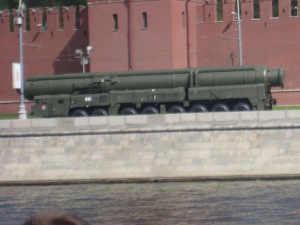 I read a lot that it's difficult for foreigners without russian language skills to get tickets at the station's offices. The offers you'll get if you book through travel agencies in Germany are usually totally overpriced and it's often impossible to book the 3rd class at all. We booked our tickets through Real Russia, a UK-based company selling tickets online. It's webpage is very useful, you can check train tables, fares and free space. We had no need to go anywhere or get the tickets via mail, as they just register our passport number and the train staff has a list with them, so your passport is your ticket. However, it seems this only worked for the first train and they don't offer that for the further trains.
I read a lot that it's difficult for foreigners without russian language skills to get tickets at the station's offices. The offers you'll get if you book through travel agencies in Germany are usually totally overpriced and it's often impossible to book the 3rd class at all. We booked our tickets through Real Russia, a UK-based company selling tickets online. It's webpage is very useful, you can check train tables, fares and free space. We had no need to go anywhere or get the tickets via mail, as they just register our passport number and the train staff has a list with them, so your passport is your ticket. However, it seems this only worked for the first train and they don't offer that for the further trains.Then we headed for the first part of the Transsiberian Railway - a 25 hour trip to Yekaterinburg (Екатеринбу́рг). While you can read in many travel guides that middle european tourists usually don't travel in the 3rd class, I was positively surprised by the quality. Everything was clean and nice. The only drawback: The bed was a bit short for my long legs. Luckily, I had the opportunity to get some more hours of sleep in a bed with an open end. Language was difficult: It seems nobody on the train was able to speak English or German. Everything went smooth, so there was no need for communication, but it may become difficult when problems arise.
While we're at it, a nice weblink: Google has the full transsiberian route on video with a map showing where you are.
Now we're in Yekaterinburg, shortly after the european-asian border. My first time in Asia.
Pictures from Moscow
Pictures from Berlin-Moscow train trip
Friday, May 6. 2011
To Asia with the train
Map by OpenStreetMap, CC by-sa
Beside finishing my studies, the last months were filled with preparations for the trip. Getting a proper bag, deciding what to take and what not, vaccinations and getting all the Visa ready - which was the most tiring part, maybe I'll write in detail about that later.
I hope I'll find time to write some blogposts and post pictures (you'll find them here as soon as I made some).
Wednesday, May 4. 2011
Diploma thesis on RSA-PSS finished
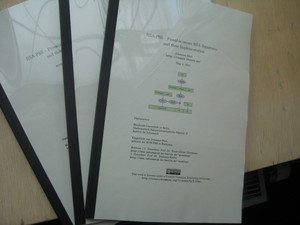 Today I submitted my diploma thesis to my university.
Today I submitted my diploma thesis to my university.The thesis summarizes several months of investigation of the Probabilistic Signature Scheme (PSS). Traditionally, RSA signatures are done by hashing and then signing them. PSS is an improved, provable secure scheme to prepare a message before signing. The main focus was to investigate where PSS is implemented and used in real world cryptographic applications with a special focus on X.509.
During my work on that, I also implemented PSS signatures for the nss library in the Google Summer of Code 2010.
The thesis itself (including PDF and latex sources), patches for nss and everything else relevant can be found at
http://rsapss.hboeck.de.
Monday, May 2. 2011
DIY recycling: High quality magnets from harddisks
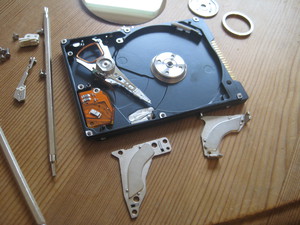 I have a magnet plate hanging over my desk. Usually, the normal magnets for that purpose you can buy in shops are of very low quality and not very strong and fail to hold more than a few pieces of paper.
I have a magnet plate hanging over my desk. Usually, the normal magnets for that purpose you can buy in shops are of very low quality and not very strong and fail to hold more than a few pieces of paper.I recently discovered a way to get much better magnets almost for free: From old harddisks. To open a harddisks, you will usually need some kind of Torx screwdriver. Inside, you will find one or two very strong neodym magnets, which were originally used to move the read head.
Posted by Hanno Böck
in Computer culture, Ecology, English, Life
at
17:24
| Comments (0)
| Trackbacks (0)
Saturday, April 23. 2011
Filmkritik: Die Mondverschwörung
Nachdem ich mehrfach gelesen hatte, dass man sich diesen Film auf keinen Fall entgehen lassen sollte, war ich heute im Kino, um mir die "Mondverschwörung" anzusehen (Trailer hier).
Der Film versucht sich satirisch der Esoterikszene und hierbei insbesondere deren rechten Auslegern anzunähern. Dennis Mascarenas arbeitet als Journalist für einen US-Sender in Deutschland (den Sender DDC gibt es wirklich und der Protagonist arbeitet dort auch tatsächlich). Zum Einstieg besucht Dennis die Lunar Embassy in den Staaten - dort ist man der Ansicht, Ansprüche auf den Mond zu haben und verkauft auch Grundstücke. Hier erfährt Dennis, dass vor einigen Jahren ein Deutscher der Lunar Embassy einen Brief geschrieben hatte, dass er der eigentliche Besitzer des Mondes sei.
Dennis sucht den angeblichen Mondbesizter in Deutschland und findet ihn auch. Von hier an interviewt er verschiedenste Esoteriker, zu Beginn des Films vor allem solche, die sich mit dem Mond auseinandersetzen - je weiter der Film fortschreitet, desto mehr rechtsradikale Thesen prägen die Interviews. Die Juden, die Zionisten und natürlich auch die USA wollen die Deutschen vergiften, wahlweise durch Chemtrails oder durch Gift in den Euro-Scheinen. Später erfährt man, dass Hitler wohl doch kein so aggressiver Mensch gewesen sein kann, weil er sonst ja nie Zutritt zur inneren Erde erhalten hätte. Flugscheiben, Neuschwabenland, Reichsdeutsche - Dennis klappert eine ganze Reihe von rechten Verschwörungstheorien ab.
Das Schema ist immer sehr ähnlich - Dennis lässt seine Gesprächspartner sich selbst blamieren und stellt meist nur neugierige Fragen. Und hier hat der Film auch seine Schwäche: Beim ersten Mal ist es lustig, auf Dauer wird das ganze aber langweilig - es passiert zu wenig, um einen ganzen Film auszufüllen.
Insofern gibt es von mir nur eine halbe Empfehlung: Der Film ist nicht schlecht, aber auch kein Meisterwerk. Wer einen netten Kinoabend sucht und dabei noch etwas über die Abgründe der deutschen Esoterikszene erfahren will, sollte ihn sich trotzdem ansehen.
Der Film versucht sich satirisch der Esoterikszene und hierbei insbesondere deren rechten Auslegern anzunähern. Dennis Mascarenas arbeitet als Journalist für einen US-Sender in Deutschland (den Sender DDC gibt es wirklich und der Protagonist arbeitet dort auch tatsächlich). Zum Einstieg besucht Dennis die Lunar Embassy in den Staaten - dort ist man der Ansicht, Ansprüche auf den Mond zu haben und verkauft auch Grundstücke. Hier erfährt Dennis, dass vor einigen Jahren ein Deutscher der Lunar Embassy einen Brief geschrieben hatte, dass er der eigentliche Besitzer des Mondes sei.
Dennis sucht den angeblichen Mondbesizter in Deutschland und findet ihn auch. Von hier an interviewt er verschiedenste Esoteriker, zu Beginn des Films vor allem solche, die sich mit dem Mond auseinandersetzen - je weiter der Film fortschreitet, desto mehr rechtsradikale Thesen prägen die Interviews. Die Juden, die Zionisten und natürlich auch die USA wollen die Deutschen vergiften, wahlweise durch Chemtrails oder durch Gift in den Euro-Scheinen. Später erfährt man, dass Hitler wohl doch kein so aggressiver Mensch gewesen sein kann, weil er sonst ja nie Zutritt zur inneren Erde erhalten hätte. Flugscheiben, Neuschwabenland, Reichsdeutsche - Dennis klappert eine ganze Reihe von rechten Verschwörungstheorien ab.
Das Schema ist immer sehr ähnlich - Dennis lässt seine Gesprächspartner sich selbst blamieren und stellt meist nur neugierige Fragen. Und hier hat der Film auch seine Schwäche: Beim ersten Mal ist es lustig, auf Dauer wird das ganze aber langweilig - es passiert zu wenig, um einen ganzen Film auszufüllen.
Insofern gibt es von mir nur eine halbe Empfehlung: Der Film ist nicht schlecht, aber auch kein Meisterwerk. Wer einen netten Kinoabend sucht und dabei noch etwas über die Abgründe der deutschen Esoterikszene erfahren will, sollte ihn sich trotzdem ansehen.
Posted by Hanno Böck
in Movies
at
01:48
| Comment (1)
| Trackbacks (0)
Defined tags for this entry: esoterik, film, filmkritik, kino, mond, mondverschwörung, verschwörungstheorie
Thursday, April 21. 2011
X.509 / SSL certificate test cases
https is likely the most widely used cryptographic protocol. It's based on X.509 certificates. There's a living debate how useful this concept is at all, mainly through the interesting findings of the EFF SSL Observatory. But that won't be my point today.
Pretty much all webpage certificates use RSA and sadly, the vast majority still use insecure hash algorithms. But it is rarely known that the X.509 standards support a whole bunch of other public key algorithms.
I've set up a page with a couple of test-cases for less-often used algorithm combinations. At the moment, it's mainly focused on RSASSA-PSS, but I plan to add elliptic curve algorithms soon. As I won't get any certificate authority to sign me certificates with anything else than classic RSA, I created my own testing root CA.
I'd be very interested to get some feedback. If you happen to have some interesting OS/Browser combination, please import the root certificate and send me a screenshot where I can see how many green ticks there are (post a link to the screenshot in the commends or send it via email).
At the moment, I'm especially looking for people to test:
Pretty much all webpage certificates use RSA and sadly, the vast majority still use insecure hash algorithms. But it is rarely known that the X.509 standards support a whole bunch of other public key algorithms.
I've set up a page with a couple of test-cases for less-often used algorithm combinations. At the moment, it's mainly focused on RSASSA-PSS, but I plan to add elliptic curve algorithms soon. As I won't get any certificate authority to sign me certificates with anything else than classic RSA, I created my own testing root CA.
I'd be very interested to get some feedback. If you happen to have some interesting OS/Browser combination, please import the root certificate and send me a screenshot where I can see how many green ticks there are (post a link to the screenshot in the commends or send it via email).
At the moment, I'm especially looking for people to test:
- Internet Explorer 9 on Windows 7
- Safari on latest MacOS X
- Internal browser on iPhone (I don't know if it's possible to install a new certificate authority there)
Wednesday, March 23. 2011
Review on Pioneer One
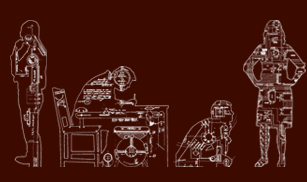 Pioneer One is a science fiction series. What's special about it: It's completely supported by donations and it's distributed via BitTorrent. It comes under a Creative Commons Attribution-NonCommercial-ShareAlike license.
Pioneer One is a science fiction series. What's special about it: It's completely supported by donations and it's distributed via BitTorrent. It comes under a Creative Commons Attribution-NonCommercial-ShareAlike license.I read about the first episode a while back, but I forgot about it. Recently, I stumbled upon it again and took the opportunity to watch it. Up until now, just two episodes are completed, Episode three is announced for 28th of March and Episode four is in production. Further episodes will depend on the donations they get.
The rough story: A space ship is coming down over Montana and lands in Canadian territory. It spreads radiation, so the first suspicion is that it might be a terrorist attack. They find a probably russian human inside the ship, unconscious, with signets from the Sovjet Union. Their suspicion: The Sovjet Union has sent humans to settle on Mars and this one is a child coming back. The case is investigated by members of the US department of homeland security.
I found it pretty good. You can see overall that it's an independent production (for example the offices just don't look like offices from the US department of homeland security), but that makes no odds. The storyline is exciting, the actors do their job pretty well, the characters are interesting. My favorite character until now is Zachary Walzer, a scientist who's been endorsing Mars missions to the US authorities for a long time.
From the story concept, I'm not sure how this will make a very long series. At the moment it sounds like at some point they know what's going on and then it may not be interesting any more. Though there were some hints in which direction it might get to continue the story after that. I'm looking forward to see more.
If I raised your interest, go ahead and download Pioneer One.
Posted by Hanno Böck
in Computer culture, Copyright, English, Movies
at
20:37
| Comments (0)
| Trackbacks (0)
Tuesday, March 1. 2011
Guttenberg: Wie konnte es eigentlich dazu kommen?
Mich juckt es gerade in den Fingern, etwas zum Fall Guttenberg loszuwerden.
Was ich mich ja gerade die ganze Zeit frage: Warum wird eigentlich seine Uni und sein Doktorvater von der Kritik weitgehend verschont? Sein Doktorvater Peter Häberle hat sich ja inzwischen dazu bequemt, sich auch mal zu dem Fall zu äußern und Guttenberg nicht weiter in Schutz zu nehmen.
Ich meine: Wie glaubwürdig ist das denn eigentlich, dass ein Doktorvater in sieben Jahren nicht bemerkt, dass sich sein Schützling offensichtlich gar nicht selbst mit dem Thema beschäftigt? Ich gehe ja naiverweise davon aus, dass in so einem Fall regelmäßige Gespräche stattfinden, in denen man sich über das Thema unterhält und diese Gedanken fließen dann später in die Dissertation ein (zumindest läuft das so bei meiner Diplomarbeit, vielleicht mache ich ja was falsch).
Ich sehe eigentlich nur zwei realistische Erklärungen: Entweder war der Doktorvater direkt am Betrug beteiligt (halte ich für unwahrscheinlich), oder eine ernsthafte Betreuung hat schlicht nicht stattgefunden und er hat nur seinen Namen dafür hergegeben. Und das ist denke ich der zweite Skandal hier, der bislang zu wenig Beachtung gefunden hat.
(dass man eigentlich auch zumindest einen rudimentären Plagiatscheck erwarten sollte, kommt natürlich dazu, aber gut, die Bedienung von Google kann man vermutlich von einem Professor nicht erwarten)
Eine weitere Anmerkung kann ich mir nicht verkneifen: Die FAZ hat die Tage einen Ghostwriter interviewt. "Die meisten Kundenwünsche kommen sowieso aus der Betriebswirtschaft oder dem juristischen Bereich" heißt es dort - ich sags mal so, das überrascht mich jetzt nicht.
Was ich mich ja gerade die ganze Zeit frage: Warum wird eigentlich seine Uni und sein Doktorvater von der Kritik weitgehend verschont? Sein Doktorvater Peter Häberle hat sich ja inzwischen dazu bequemt, sich auch mal zu dem Fall zu äußern und Guttenberg nicht weiter in Schutz zu nehmen.
Ich meine: Wie glaubwürdig ist das denn eigentlich, dass ein Doktorvater in sieben Jahren nicht bemerkt, dass sich sein Schützling offensichtlich gar nicht selbst mit dem Thema beschäftigt? Ich gehe ja naiverweise davon aus, dass in so einem Fall regelmäßige Gespräche stattfinden, in denen man sich über das Thema unterhält und diese Gedanken fließen dann später in die Dissertation ein (zumindest läuft das so bei meiner Diplomarbeit, vielleicht mache ich ja was falsch).
Ich sehe eigentlich nur zwei realistische Erklärungen: Entweder war der Doktorvater direkt am Betrug beteiligt (halte ich für unwahrscheinlich), oder eine ernsthafte Betreuung hat schlicht nicht stattgefunden und er hat nur seinen Namen dafür hergegeben. Und das ist denke ich der zweite Skandal hier, der bislang zu wenig Beachtung gefunden hat.
(dass man eigentlich auch zumindest einen rudimentären Plagiatscheck erwarten sollte, kommt natürlich dazu, aber gut, die Bedienung von Google kann man vermutlich von einem Professor nicht erwarten)
Eine weitere Anmerkung kann ich mir nicht verkneifen: Die FAZ hat die Tage einen Ghostwriter interviewt. "Die meisten Kundenwünsche kommen sowieso aus der Betriebswirtschaft oder dem juristischen Bereich" heißt es dort - ich sags mal so, das überrascht mich jetzt nicht.
Saturday, February 26. 2011
Playing with the EFF SSL Observatory
The Electronic Frontier Foundation is running a fascinating project called the SSL Observatory. What they basically do is quite simple: They collected all SSL certificates they could get via https (by scanning all possible IPs), put them in a database and made statistics with them.
For an introduction, watch their talk at the 27C3 - it's worth it. For example, they found a couple of "Extended Validation"-Certificates that clearly violated the rules for extended validation, including one 512-bit EV-certificate.
The great thing is: They provide the full mysql database for download. I took the time to import the thing locally and am now able to run my own queries against it.
Let's show some examples: I'm interested in crypto algorithms used in the wild, so I wanted to know which are used in the wild at all. My query:
And the result:
This query was only for the valid certs, meaning they were signed by any browser-supported certificate authority. Now I run the same query on the all_certs table, which contains every cert, including expired, self-signed or otherwise invalid ones:
For an introduction, watch their talk at the 27C3 - it's worth it. For example, they found a couple of "Extended Validation"-Certificates that clearly violated the rules for extended validation, including one 512-bit EV-certificate.
The great thing is: They provide the full mysql database for download. I took the time to import the thing locally and am now able to run my own queries against it.
Let's show some examples: I'm interested in crypto algorithms used in the wild, so I wanted to know which are used in the wild at all. My query:
SELECT `Signature Algorithm`, count(*) FROM valid_certs GROUP BY `Signature Algorithm` ORDER BY count(*);shows all signature algorithms used on the certificates.
And the result:
+--------------------------+----------+Nothing very surprising here. Seems nobody is using anything else than RSA. The most popular hash algorithm is SHA-1, followed by MD5. The transition to SHA-256 seems to go very slowly (btw., the most common argument I heared when asking CAs for SHA-256 certificates was that Windows XP before service pack 3 doesn't support that). The four MD2-certificates seem interesting, though even that old, it's still more secure than MD5 and provides a similar security margin as SHA-1, though support for it has been removed from a couple of security libraries some time ago.
| Signature Algorithm | count(*) |
+--------------------------+----------+
| sha512WithRSAEncryption | 1 |
| sha1WithRSA | 1 |
| md2WithRSAEncryption | 4 |
| sha256WithRSAEncryption | 62 |
| md5WithRSAEncryption | 29958 |
| sha1WithRSAEncryption | 1503333 |
+--------------------------+----------+
This query was only for the valid certs, meaning they were signed by any browser-supported certificate authority. Now I run the same query on the all_certs table, which contains every cert, including expired, self-signed or otherwise invalid ones:
+-------------------------------------------------------+----------+It seems quite some people are experimenting with DSA signatures. Interesting are the number of GOST-certificates. GOST was a set of cryptography standards by the former soviet union. Seems the number of people trying to use elliptic curves is really low (compared to the popularity they have and that if anyone cares for SSL performance, they may be a good catch). For the algorithms only showing numbers, 1.2.840.113549.1.1.10 is RSASSA-PSS (not detected by current openssl release versions), 1.3.6.1.4.1.5849.1.3.2 is also a GOST-variant (GOST3411withECGOST3410) and 1.2.840.113549.27.1.5 is unknown to google, so it must be something very special.
| Signature Algorithm | count(*) |
+-------------------------------------------------------+----------+
| 1.2.840.113549.27.1.5 | 1 |
| sha1 | 1 |
| dsaEncryption | 1 |
| 1.3.6.1.4.1.5849.1.3.2 | 1 |
| md5WithRSAEncryption ANDALSO md5WithRSAEncryption | 1 |
| ecdsa-with-Specified | 1 |
| dsaWithSHA1-old | 2 |
| itu-t ANDALSO itu-t | 2 |
| dsaWithSHA | 3 |
| 1.2.840.113549.1.1.10 | 4 |
| ecdsa-with-SHA384 | 5 |
| ecdsa-with-SHA512 | 5 |
| ripemd160WithRSA | 9 |
| md4WithRSAEncryption | 15 |
| sha384WithRSAEncryption | 24 |
| GOST R 34.11-94 with GOST R 34.10-94 | 25 |
| shaWithRSAEncryption | 50 |
| sha1WithRSAEncryption ANDALSO sha1WithRSAEncryption | 72 |
| rsaEncryption | 86 |
| md2WithRSAEncryption | 120 |
| GOST R 34.11-94 with GOST R 34.10-2001 | 378 |
| sha512WithRSAEncryption | 513 |
| sha256WithRSAEncryption | 2542 |
| dsaWithSHA1 | 2703 |
| sha1WithRSA | 60969 |
| md5WithRSAEncryption | 1354658 |
| sha1WithRSAEncryption | 4196367 |
+-------------------------------------------------------+----------+
Posted by Hanno Böck
in Computer culture, Cryptography, English, Science, Security
at
22:40
| Comments (0)
| Trackbacks (0)
Defined tags for this entry: algorithm, certificate, cryptography, eff, observatory, pss, rsa, security, ssl
Saturday, February 12. 2011
Berlin: Morgen mit "Ja" abstimmen
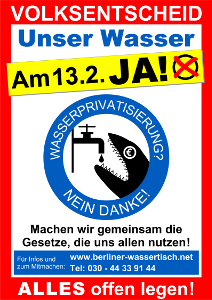 Ich hatte vor einer Weile schon für das Volksbegehren zur Offenlegung der Berliner Wasserverträge hier geworben.
Ich hatte vor einer Weile schon für das Volksbegehren zur Offenlegung der Berliner Wasserverträge hier geworben.Zwischenzeitlich hat es einige Entwicklungen gegeben. Die notwendigen Unterschriften wurden gesammelt, wenige Tage später veröffentlichte die taz die Verträge im Internet. Dadurch wurden die meisten Befürchtungen, die vorher nur auf Gerüchten basierten, bestätigt.
Doch das Volksbegehren bezog sich nicht nur auf die Verträge über die Berliner Wasserversorgung. Es soll ganz generell Transparenz über Verträge zwischen der öffentlichen Hand und privaten Firmen herrschen. Weiterhin sollen Verträge, die nicht veröffentlicht werden, auch nicht gültig sein. Die Details sind etwas komplexer, wer sich für näheres interessiert, darf gerne die umfangreiche Webseite des Berliner Wassertischs besuchen.
Weswegen ich eigentlich schreibe: Der Volksentscheid hierüber findet morgen (Sonntag) statt - und alle BerlinerInnen, die hier mitlesen, möchte ich auffordern, hinzugehen und mit "Ja" zu stimmen.
Update: Ich lag mit dem was ich da geschrieben (und nun durchgestrichen) habe wohl nicht ganz richtig (sorry, habe mich unzureichend informiert) - tatsächlich bezog sich das Volksbegehren »nur« auf die Wasserverträge. Außerdem: Nach aktuellem Stand war der Volksentscheid erfolgreich!
Thursday, January 27. 2011
Energy effiency of cable modems and routers
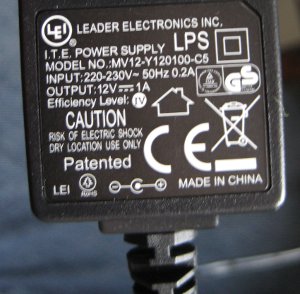 I already wrote in the past that a couple of times that I'm worried about the insane high energy consumption of DSL and WLAN hardware that's supposed to run all the time.
I already wrote in the past that a couple of times that I'm worried about the insane high energy consumption of DSL and WLAN hardware that's supposed to run all the time.Recently, I switched my internet provider from O2 to Kabel Deutschland and got new hardware. I made some findings I found interesting:
It seems very many power supplies today have a label on their energy effiency. If you find something called "EFFIENCY LEVEL: V" - that's it. V is currently the best, I the worst. Higher values are reserved for the future (so this is much more intelligent than the stupid EU energy label, where A stands for "this was the best when we invented this label some years ago"). I haven't tried that yet, but from what I read it seems worth replacing inefficient power supplies with better ones.
The cable modem I got eats 4 Watts. Considering that it's the crucial part that cannot be switched off as long as I want to be able to receive phone calls, I consider this rather high. The power supply had effiency level IV. If anyone knows of any energy saving cable modems, I'm open for suggestions.
I was quite impressed by the router I got for free. It's a D-Link 615 and it's using 2,4 Watts with wireless and 1,4 Watts without. That's MUCH better than anything I've seen before. So at least we see some progress here. (and for people interested in free software: it seems at least DD-WRT claims to support it and the other *WRT projects are working on it)
Though I still fail to understand why there can't be a simple law stating that every electronic device must put information about it's energy consumption on the package.
Posted by Hanno Böck
in Ecology, English, Linux
at
21:22
| Comment (1)
| Trackbacks (0)
Defined tags for this entry: cablemodem, climate, d-link, ecology, efficiency, eletricity, environment, kabeldeutschland, o2, router, strom, stromverbrauch, umwelt
« previous page
(Page 10 of 57, totaling 848 entries)
» next page
